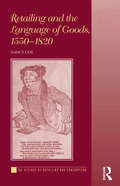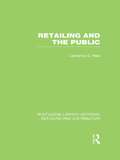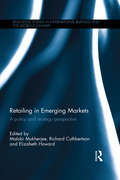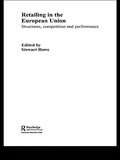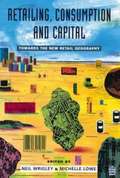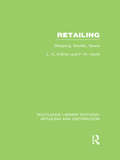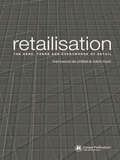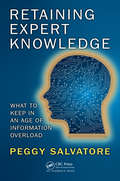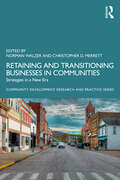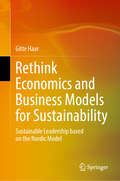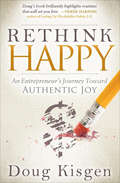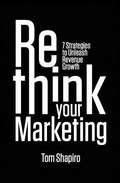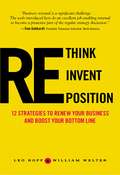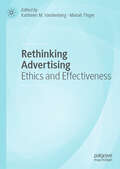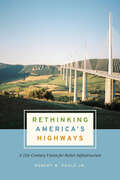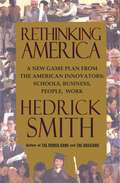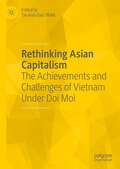- Table View
- List View
Retailing and E-tailing
by Mickey Kosloski Sharon R. DavisRetailing and E-tailing integrates the four Ps of marketing into the operations of retail and e-tail businesses. Retail-specific topics in the areas of business operations, merchandising, customer service, and selling are presented. The differences between traditional retail operations and e-tailing are also explored. College and career readiness activities covering writing, speaking, and listening are addressed. Career Ready Practices are also included.
Retailing and the Language of Goods, 1550-1820 (The\history Of Retailing And Consumption Ser.)
by Nancy CoxIn this book the author explores the various meanings assigned to goods sold retail from 1550 to 1820 and how their labels were understood. The first half of the book focuses on these labels and on mercantile language more broadly; how it was used in trade and how lexicographers and others approached what, for them, were new vocabularies. In the second half, the author turns to the goods themselves, and their relationships with terms such as ’luxury’, ’choice’ and ’love’; terms that were used as descriptors in marketing goods. The language of objects is a subject of ongoing interest and the study of consumables opens up new ways of looking at the everyday language of the early modern period as well as the experiences of trade and consumption for both merchant and consumer.
Retailing and the Public (Routledge Library Editions: Retailing and Distribution)
by Lawrence E. NealIn one of the first books to treat retailing as a subject of serious analysis, Retailing and the Public examines the state of one of the most important industries in the country. Retailing gives direct employment to more people than any other trade; it accounts for over half of national income. No other industry affects the public as much as retailing does. These facts stand as true today as they did in the 1930s, and this classic text, groundbreaking in its time, shines as much light on the present as it does the past. First published 1932.
Retailing in Emerging Markets: A policy and strategy perspective (Routledge Studies in International Business and the World Economy)
by Richard Cuthbertson Elizabeth Howard Malobi MukherjeeRetailing is changing extremely rapidly in the emerging economies, both as a driver of social and economic change, and a consequence of economic development and the rise of consumer societies. Changes that took many decades in Europe or North America are happening at a much greater speed in emerging markets, while regulations continue to be hotly contested in these markets, raising questions about appropriate business strategies for both globalising firms and local contenders. While much has been written about retail in emerging markets, the focus has been primarily on the nature of entry strategies for Western retail companies. This book seeks to capture the impact of both internal and external regulations on retail development and strategy in emerging markets. It provides a comprehensive and up-to-date assessment of the development of retailing in a wide range of emerging economies, and seeks to capture the interplay between both retail policy and retail strategy and the theoretical implications of this on retail development as a whole. This book will be of interest to academics, researchers and advanced students with an interest in retail development in emerging markets, international business/strategy and international marketing.
Retailing in the European Union
by Stewart HoweAs retailing becomes increasingly important in global economics, the similarities and differences of retailing from country to country are now more evident. This unique and timely study of retail structures across Europe, gives an insightful overview of the internationalization of retailing and asks important questions regarding the effectiveness of different retailing sectors. With chapters on Denmark, France, Germany, Greece, Italy, Spain and the United Kingdom, this contemporary study examines the extent to which Europe's increasingly homogenous environment applies to retailing. By considering overall structural and socio-economic variables of country-to-country retailing, it draws fascinating conclusions on efficiency and competition within the European Union. A major contribution to the field of European retail studies, this significant work in comparative legislation is essential reading for anyone studying retailing at postgraduate or undergraduate level or with an interest in comparative economics.
Retailing, Consumption And Capital: Towards The New Retail Geography
by Neil Wrigley Michelle LoweRetail geography is in the process of positioning itself at the centre of a number of key debates on services, consumption and capital. Retailing can no longer be treated as being only indirectly associated with the 'real' world of production, but rather at the 'leading edge' of new developments within labour practices and the social relations of production. This text provides an innovative collection of chapters, giving an informed analysis of the transformation of the retail sector. It includes corporate restructuring and retailer-manufacturer-regulatory state relations, retail employment relations, consumption and capital, and retailer internationalization.
Retailing: Shopping, Society, Space (Routledge Library Editions: Retailing and Distribution)
by Frank Harris Larry O'BrienThis textbook provides an up-to-date, comprehensive and fully integrated treatment of retailing as a) and industry, b) a force shaping social attitudes and contemporary culture, and c) a force for change in modern townscapes. Unlike other texts which focus on specific topics, this book provides a treatment of retailing which will appeal to geographers, economists, planners and social scientists. First published 1991.
Retailisation: The Here, There and Everywhere of Retail
by Robin Hunt Francesca de ChâtelInvestigates the current state of selling, whether this is groceries, politicians, information or motorcars. Unlike any other phenomenon, retailization reflects the complexity and diffusion of information processes and the media in the online market. The authors explore the all-pervasive nature of retail in the physical world, the virtual world and the peripheral spaces in between.Coverage includes:interviews with Asda, MOMA, the Tate Modern, Wal-Mart, Sony, Habitat, Manchester United and Volkswagen, while Bill Mitchell, Dean of Architecture at MIT, architects Jon Jerde, Rem Koolhas and Ben van Berkel, as well as David Peek, psychologist behind the Bluewater Shopping Mall, are all individually interviewed.
Retaining Expert Knowledge: What to Keep in an Age of Information Overload
by Peggy SalvatoreRetaining Expert Knowledge is a training resource, but it is also a business resource. As knowledge proliferates and organizational culture rapidly changes, now is the time to step back and determine what has been important to your organization’s success, where the organization is today, and what it will take to stay in the game tomorrow. Your company houses knowledge, skills, attitudes, intellectual property, trade secrets, company culture, and individuals who will never be replicated exactly as they are today. <P><P>Because they have demonstrated value in the past and are demonstrating value today, these treasures are worth preserving. This book shows how to preserve these valuable assets today for tomorrow’s successes.
Retaining and Transitioning Businesses in Communities: Strategies in a New Era (Community Development Research and Practice Series)
by Norman Walzer Christopher D. MerrettThis edited collection presents successful business succession planning in smaller rural communities where profit margins are low, markets are shrinking, and there are few potential buyers. Finding innovative ways to successfully transition these businesses to new owners is at the heart of community and economic development efforts if many of these communities are to thrive in the future. Chapters outline options for successfully transitioning businesses that have worked in Canada, England, and the U.S. The book explores a variety of alternative approaches to transitioning small businesses to new owners using a different ownership model. A common theme running through these approaches is that employees and/or members of the community are engaged in working with or possibly owning the business in some cases. The book's discussions are not prescriptive, recommending specific models or strategies. Instead, they provide valuable insights into viable alternatives and suggest additional resource materials. This book is essential for academics, policymakers, and practitioners working on community and economic development issues, especially in areas with aging populations.
Retargeting und die Rolle des Online-Shopping-Momentums: Theoretische Fundierung und empirische Analyse (Applied Marketing Science / Angewandte Marketingforschung)
by Isabelle KesVor dem Hintergrund einer stetig zunehmenden Verschiebung von Werbebudgets in den Online-Bereich bei gleichzeitig lauter werdendem Ruf nach fairerer, wirkungsbasierter Attribution über alle Marketing-Kanäle hinweg zielt die vorliegende Arbeit darauf ab, einen signifikanten Beitrag zur Schließung der bestehenden Forschungslücken zur Effektivität verhaltensbasierter Werbung zu leisten sowie offene Fragen der Praxis zur Wirkung von Retargeting zu beantworten. Basierend auf drei empirische Studien zeigt Isabelle Kes, dass sich das Phänomen eines Momentums in einem Online-Shopping-Kontext nachweisen lässt. Sie liefert einen konzeptionellen Rahmen zur Erklärung der Wirkungsweisen von Retargeting und attestiert eine positive und beschleunigende Wirkung unter bestimmten, moderierenden Voraussetzungen und damit einen signifikanten Einfluss des Momentums auf die Wirkung von Retargeting. Zudem zeigt sich ein zeitlich variierender (positiver) Effekt, der durch die strategische Ausgestaltung von Retargeting-Kampagnen forciert werden kann.
Retention Point: The Single Biggest Secret to Membership and Subscription Growth
by Robert Skrob<p>Membership Growth Comes From Retention, Not From Getting New Members. <p>You know those members who love you, buy everything you offer and tell all their friends about you? Those members have made it to the Retention Point. And, when you do what I show you how to do in the book, you’ll get MORE of your members to the Retention Point so you can keep them longer and your recurring revenue will grow. <p>Membership is a great business model in concept. You get a customer and each time your customer renews you get recurring revenue. But, even though I’d become a membership marketing expert I soon discovered it doesn’t matter how many new members you get if your members quit as fast as new members join. <p>When you get your hands on this book you'll discover: <p> <li>The five fallacies of membership retention that most subscription businesses implement that actually INCREASE member churn rates. <li>Five case studies of subscription business turnarounds (or successful launches) including a publisher, a subscription box, SAAS, an association and a charity/nonprofit. <li>The 10 Retention Point Accelerators that transform your new members from Quitters into Lifers. <li>How to achieve 90% to 98% annual renewal percentages, even if you believe this is completely impossible for your business. <li>The single biggest misunderstanding subscription companies believe that kills membership growth.</li> </p>
Rethink Economics and Business Models for Sustainability: Sustainable Leadership based on the Nordic Model
by Gitte HaarThe overall framework for leaders is now changing and a reassessment of traditional economic and financial models is called for to foster the green and circular transition. The Nordic countries may offer some of the values and leadership trends needed to implement sustainable leadership. Sustainable leadership is necessary to attract new generations of customers and employees, and to drive the great transition to a green economy. Leaders need new competences and new values to prepare their companies for the new market conditions and geopolitical situation. Managing businesses’ impacts throughout the value chain is the new normal and sustainability is a business imperative. In this regard, the Sustainable Development Goals can offer guidance. The Nordic societies have proven to be forerunners in terms of developing SDG-oriented business strategies, and their economies remained resilient and stable through the financial crisis and the COVID-19 pandemic. Using the Nordic example, this book discusses how the transformation of business models, organizations, and societies, as well as the pricing of externalities, will be essential to operating within the boundaries of a fair and sustainable world. The book introduces a UN SDG Fund and explains the value of sending executives on “Højskole” – a Danish journey of lifelong learning and the continuous acquisition of new leadership skills and values. In addition, it presents the new concepts of the “Strategic House” and “Purpose Gap,” while adapting Porter’s value chain into a Circular Organization Model. The book also features a catalogue of proven methods and guidelines to assist companies in transforming their businesses towards sustainability, ESG, and regenerative impacts.
Rethink HIV: Smarter Ways to Invest in Ending HIV in Sub-Saharan Africa
by Bjørn LomborgThirty years after the identification of the disease that became known as AIDS, humanitarian organizations warn that the fight against HIV/AIDS has slowed, amid a funding shortfall and donor fatigue. In this book, Bjørn Lomborg brings together research by world-class specialist authors, a foreword by UNAIDS founding director Peter Piot and perspectives from Nobel Laureates and African civil society leaders to identify the most effective ways to tackle the pandemic across sub-Saharan Africa. There remains an alarming lack of high-quality data evaluating responses to HIV. We still know too little about what works, where and how to replicate our successes. This book offers the first comprehensive attempt by teams of authors to analyze HIV/AIDS policy choices using cost-benefit analysis, across six major topics. This approach provides a provocative fresh look at the best ways to scale up the fight against this killer epidemic.
Rethink Happy: An Entrepreneur's Journey Toward Authentic Joy
by Doug KisgenA profoundly inspiring parable for anyone who has experienced success—and wondered if there is something more . . . Cleve has it all. Or so he thinks. Then an apparent chance encounter with an old man named Camino causes him to realize that what he believes is happiness is merely a shadow of the joy he could experience. Yes, having money and cool cars and freedom is fun, but happiness is not a result of accumulating stuff. Told in a compelling parable format, Rethink Happy challenges readers to redefine authentic joy. Join Cleve as Camino leads him on a journey through three key principles of old-school philosophy and new-school science that can inspire anyone who has wondered how to achieve true happiness, struggled with how to be successful at home as well as in business, or tried to make sense of setbacks. From an entrepreneur who has faced—and bounced back from—disaster, and learned that success and happiness has less to do with him and his ego and more to do with something deeper, Rethink Happy is an inspiring story for anyone facing obstacles in work or in life.
Rethink Property Investing, Fully Updated and Revised Edition: Become Financially Free with Commercial Property Investing
by Scott O'Neill Mina O'NeillThe definitive guide to building a profitable commercial property portfolio — now fully updated and revised Australia’s bestselling commercial property book, Rethink Property Investing, offers practical advice for any investor looking to move beyond traditional residential real estate and enter the profitable world of commercial properties. Leading investors Scott and Mina O’Neill show you how they retired at the age of 28 and now live off the income generated by their $75 million commercial property portfolio. This invaluable guide dispels the investing myths and demystifies complex property principles and strategies using a clear, straightforward, and easy-to-understand approach. This is the book Scott and Mina wished they had when they started out: an honest, no-nonsense handbook filled with practical examples, personal stories, expert advice and real-world information. Rethink Property Investing aims to help you earn enough passive income to retire early and enjoy your life — whether you’re a residential property investor looking to go to the next level or an experienced investor seeking a more advanced approach. Now fully updated and revised, this edition shares detailed new property examples and gives the lowdown on value-add opportunities and investment strategies like syndicates. Rethink Property Investing will show you how to: Build your own commercial property portfolio following 7 Easy Steps and the Top 5 Property Plays Follow the strategies Scott and Mina O'Neill used to build a $75 million portfolio in 12 years Maximise the performance of your existing property portfolio using proven techniques Understand how different commercial properties perform, especially in the current economic climate and with current interest rates Find the best commercial property opportunities available today so you can build a $200K passive income Learn how you can create wealth successfully through commercial property investing, using simple yet powerful strategies from two people who have been there and done that. From developing an investment mindset to financing and managing your property, Rethink Property Investing will guide you every step of the way.
Rethink Property Investing: Become Financially Free with Commercial Property Investing
by Scott O'Neill Mina O'NeillThe definitive guide to building a profitable commercial property portfolio Rethink Property Investing offers practical advice for both new and established investors looking to move beyond traditional residential real estate and enter the profitable world of commercial properties. Scott and Mina O’Neill, Australia’s leading commercial property investors and founders of Rethink Investing, show you how they retired at the age of 28 and now live off the income generated by their $20 million property portfolio. This invaluable guide dispels the investing myths and demystifies complex property principles and strategies using a clear, straightforward, and easy-to-understand approach. This is the book Scott and Mina O’Neill wished they had when they started out: an honest, no-nonsense book filled with practical examples, personal stories, expert advice and real-world information. Whether you’re a residential property investor looking to go to the next level or an experienced investor seeking a more advanced approach to commercial property, Rethink Property Investing is written to help you earn enough passive income to retire early and enjoy life. Learn how you can achieve unlimited success through commercial property investing using simple yet powerful strategies from two people who have already done it—and are willing to share their wisdom. Rethink Property Investing will teach you to: Follow the 7 Easy Steps and use the Top 5 Property Plays to build a commercial property portfolio How Scott and Mina O’Neill built a $20 million portfolio in 10 years and how you can follow their strategy Maximise the performance of your existing property portfolio using proven techniques Profit from the different ways commercial properties perform in the COVID-19 environment Enjoy the virtually limitless success that commercial property investing can bring Now is the time to create wealth in the long term with commercial property investing. From developing an investment mindset to financing and managing your property, Rethink Property Investing will guide you through every step.
Rethink Your Marketing: 7 Strategies To Unleash Revenue Growth
by Tom ShapiroIf your business is stuck and you just cannot seem to grow beyond your current plateau, Rethink Your Marketing arms you with seven strategies for getting unstuck to fuel your revenue growth. Rethink Your Marketing helps you to identify the specific levers of your marketing that will lead to new growth, enabling you to cut through the noise to what truly moves the needle.
Rethink, Reinvent, Reposition
by Leo Hopf William WelterIs your business struggling to stay afloat? Are you overwhelmed by the challenge of building an organization that can be a market leader? Well, now is the time to stop going in circles-find a new direction and re-imagine your company. In this hard-hitting guide, renowned international corporate consultants and professors Leo Hopf and William Welter show how to breathe new life into your firm. Using revealing case studies from Seagate to Harley-Davidson, they offer such key strategies as:Repackaging products to widen the range of your target demographic Revising your profit model to improve your margins Moving up- or down-market to attract new customers Using core competencies to enter new markets Conducting business at a different time to reach new customers You'll need to take a risk to reap the rewards. But this blueprint for growth will supply you with the confidence to start on a different path. So forget the same-old tired tactics. Instead, make things happen by making over your business! It's crucial to the livelihood of your enterprise, and Hopf and Welter give you everything you need to get it right.
Rethink, Reinvent, Reposition
by Leo Hopf William WelterIs your business struggling to stay afloat? Are you overwhelmed by the challenge of building an organization that can be a market leader? Well, now is the time to stop going in circles-find a new direction and re-imagine your company. In this hard-hitting guide, renowned international corporate consultants and professors Leo Hopf and William Welter show how to breathe new life into your firm. Using revealing case studies from Seagate to Harley-Davidson, they offer such key strategies as:Repackaging products to widen the range of your target demographic Revising your profit model to improve your margins Moving up- or down-market to attract new customers Using core competencies to enter new markets Conducting business at a different time to reach new customers You'll need to take a risk to reap the rewards. But this blueprint for growth will supply you with the confidence to start on a different path. So forget the same-old tired tactics. Instead, make things happen by making over your business! It's crucial to the livelihood of your enterprise, and Hopf and Welter give you everything you need to get it right.
Rethink, Reinvent, Reposition: 12 Strategies to Make Over Your Business
by Leo HopfIs your business struggling to stay afloat? Are you overwhelmed by the challenge of building an organization that can be a market leader? Well, now is the time to stop going in circles-find a new direction and re-imagine your company. In this hard-hitting guide, renowned international corporate consultants and professors Leo Hopf and William Welter show how to breathe new life into your firm.Using revealing case studies from Seagate to Harley-Davidson, they offer such key strategies as:Repackaging products to widen the range of your target demographicRevising your profit model to improve your marginsMoving up- or down-market to attract new customersUsing core competencies to enter new marketsConducting business at a different time to reach new customers You'll need to take a risk to reap the rewards. But this blueprint for growth will supply you with the confidence to start on a different path. So forget the same-old tired tactics. Instead, make things happen by making over your business! It's crucial to the livelihood of your enterprise, and Hopf and Welter give you everything you need to get it right.
Rethinking Advertising: Ethics and Effectiveness
by Mariah Tinger Kathleen M. VandenbergWith more mediums than ever across which to advertise, businesses are facing increasing marketing costs even as customers continue to turn toward services offering ad-free entertainment. These changes mean the advertising ecosystem is undergoing dramatic alterations, with massive online companies like Facebook and Google capturing a majority of advertising dollars and smaller advertising agencies failing. Against this rapidly-shifting backdrop, this edited volume showcases current academic perspectives and research cases on advertising from scholars representing a wide range of disciplines. The contributions in this book create a comprehensive overview of the current state of advertising—across many media—while highlighting conversations concerning the ethics of advertising and the most effective ways to advertise. Interdisciplinary by nature, this book includes perspectives from academics in marketing, communications, law, rhetoric, and business. It will be of great interest to scholars and students seeking a thought provoking debate
Rethinking America's Highways: A 21st-Century Vision for Better Infrastructure
by Robert W. PooleAmericans spend hours every day sitting in traffic. And the roads they idle on are often rough and potholed, their exits, tunnels, guardrails, and bridges in terrible disrepair. According to transportation expert Robert Poole, this congestion and deterioration are outcomes of the way America provides its highways. Our twentieth-century model overly politicizes highway investment decisions, short-changing maintenance and often investing in projects whose costs exceed their benefits. In Rethinking America’s Highways, Poole examines how our current model of state-owned highways came about and why it is failing to satisfy its customers. He argues for a new model that treats highways themselves as public utilities—like electricity, telephones, and water supply. If highways were provided commercially, Poole argues, people would pay for highways based on how much they used, and the companies would issue revenue bonds to invest in facilities people were willing to pay for. Arguing for highway investments to be motivated by economic rather than political factors, this book makes a carefully-reasoned and well-documented case for a new approach to highways that is sure to inform future decisions and policies for U.S. infrastructure.
Rethinking America: A New Game Plan from the American Innovators: Schools, Business, People, Work
by Hedrick SmithThe Pulitzer Prize-winning, bestselling author of The Russians, The Power Game, and The New Russians shows how America has lost ground, and reveals how innovators are creating new strategies to win in the new global game.
Rethinking Asian Capitalism: The Achievements and Challenges of Vietnam Under Doi Moi
by Thi Anh-Dao TranThis book attempts to reflect on the changes that Vietnam has experienced over the past 30 years, during and after DoiMoi. Through multi-dimensional empirical investigations, it aims to offer theoretical and empirical accounts for how a variety of socioeconomic regimes emerged after the end of the Cold War. Being methodologically pluralist (including both theoretical and empirical studies), it aims to give a higher profile to heterodox thinking in comparative political economy. Particular attention is given to post-socialist governance, economic transformation, land rights, trade-led growth, civil society participation, climate change, and the post-COVID 19 recovery. This book comes at a time when great changes are about to take place in Southeast Asia, where heterodox economic development strategy is rather understudied. With Asia playing an increasingly important role in the world economy, readers wish not only to hear about the economic transformation but also to see certain hidden aspects or original evidence in order that they can perceive the other dimensions put in place in a market-oriented economy. It will be relevant to students and researchers interested in transitional economics, development economics and the political economy.

